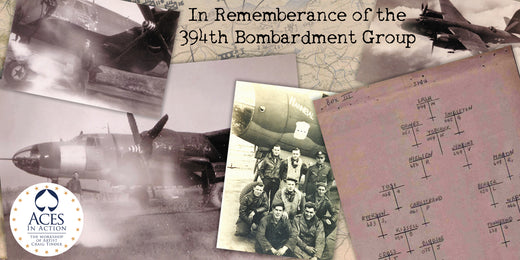This Fine Art Print by Artist Craig Tinder pays tribute to the pilots and crews of the 394th Bombardment Group during 6 June 1944, D-Day. This Limited Edition Canvas Print includes an actual fragment from B-26F Marauder 42-96263 which was lost on 6 June 1944.
Details About the RELIC:
This original aluminum fragment is from B-26F 42-96263 "Spook" which took off from RAF Boreham at 5:05am on 6 June 1944. Due to poor visibility that morning, eyewitness testimony saw two B-26s break from a large dark cloud and collide over Gillingham, Kent, England. Both aircraft, B-26F 42-96263 (Aircraft: 5W-S) and B-26B 42-96050 (Aircraft: 5W-L) were en route to attack enemy gun positions just behind Utah Beach.
 B-26F serial number 42-96263 airframe fragment
B-26F serial number 42-96263 airframe fragment
This fragment along with many other recovered aircraft components were acquired by Aces In Action in 2022 and were originally on display at the Blake Hall Airscene Collection, Essex, UK. To further this story of rememberance, Artist, Craig Tinder depicted a scene of that very bomb squadron making their way to the shores of Normandy.
 "Clearing the Path to Utah" Framed Canvas with Relic
"Clearing the Path to Utah" Framed Canvas with Relic
The Story Behind the Print:
In the early hours of D-Day, June 6, 1944, while the world’s attention focused on the Allied invasion of Normandy, aircraft from all over England were preparing in support missions. Two American B-26 Marauders, B-26F 42-96263 ("Spooky") and B-26B 42-96050, from the 394th Bombardment Group, 587th Bombardment Squadron, were en route to support the invasion when they collided mid-air at approximately 5:05 AM. Poor weather conditions, including limited visibility, clouds, and light rain, were believed to be contributing factors in the accident. Eyewitness reports were limited, but hearsay indicated that one aircraft was flying beneath the overcast sky while the other descended from a black cloud, leading to the tragic collision.
 Allied invasion of 394th Bombardment Group
Allied invasion of 394th Bombardment Group
The 394th Bombardment Group was tasked with a vital mission in support of the D-Day landings: to neutralize German gun batteries at Saint-Martin-de-Varreville, located just off Utah Beach in Normandy.
The B-26 Marauders of Formation Box III set course for the gun batteries shortly before the first waves of Allied troops landed on the beaches. Despite heavy flak from German anti-aircraft defenses, most of the squadron successfully completed their bombing runs, ensuring that the batteries would not interfere with the landings below.
 394th Box Formation - the artist used this to research placement of aircraft in the artpiece
394th Box Formation - the artist used this to research placement of aircraft in the artpiece
Tragically, however, two aircraft—B-26F 42-96263 and B-26B 42-96050—never reached their target. Shortly after takeoff, these two Marauders collided mid-air over Gillingham, Kent, England.
 B-26F 42-96263 "Spook" - Lost in collision
B-26F 42-96263 "Spook" - Lost in collision
 B-26F 42-96049 Lead aircraft for mission and focus point for art piece
B-26F 42-96049 Lead aircraft for mission and focus point for art piece
 B-26F "Hannibal" - Bottom right aircraft depicted in art piece
B-26F "Hannibal" - Bottom right aircraft depicted in art piece
 B-26F 42-96049 - Top left aircraft depicted in art piece
B-26F 42-96049 - Top left aircraft depicted in art piece
Learn more about The Journey of B-26 Marauder in Preserving History, Click Here
To purchase or see similar items, visit here.
Commissioned by Museums, Treasured by Collectors





Share:
Supersonic Legacy, the story behind "Shooting Star"
Sky Warriors, the story behind "Return of the Wolf Gang"